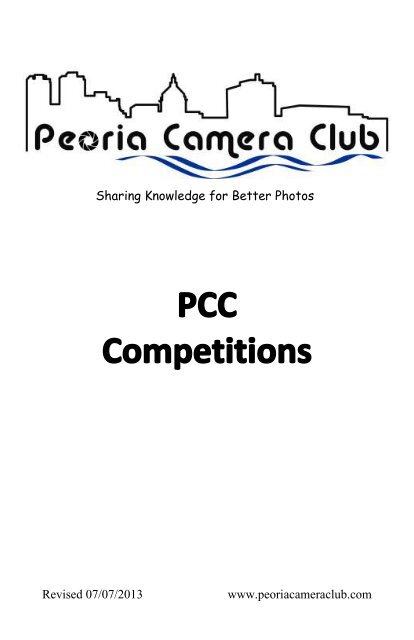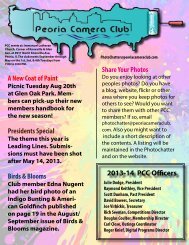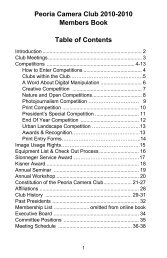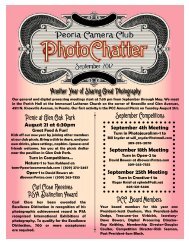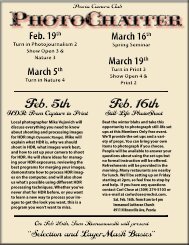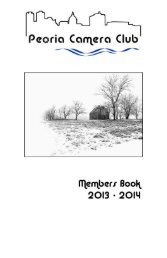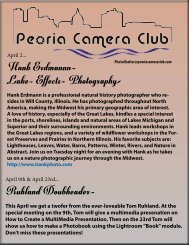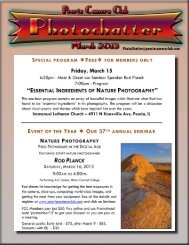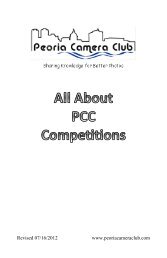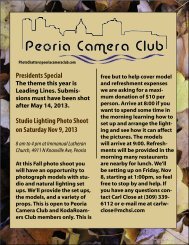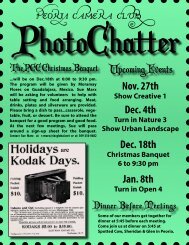Competition Book - Peoria Camera Club
Competition Book - Peoria Camera Club
Competition Book - Peoria Camera Club
Create successful ePaper yourself
Turn your PDF publications into a flip-book with our unique Google optimized e-Paper software.
Sharing Knowledge for Better Photos<br />
Revised 07/07/2013<br />
www.peoriacameraclub.com
Contents<br />
All guidelines and rules in this booklet are for <strong>Peoria</strong><br />
<strong>Camera</strong> <strong>Club</strong> competitions. Other organizations may<br />
have different guidelines and rules.<br />
Basic <strong>Competition</strong> Process …………………………………. 1<br />
<strong>Competition</strong>s......................................................................... 2<br />
Member Number …………………………………………….. 2<br />
Judging ………………………………………………………… 2<br />
‘<strong>Club</strong>s’ Within the <strong>Club</strong> ……………………………………..... 3<br />
Creative Digital Image Definition & Rules………………….. 4<br />
Open Digital Image Definition & Rules …………………….. 4<br />
Nature Digital Image Definition & Rules……………………. 5<br />
Photojournalism Digital Image Definition & Rules…………. 6<br />
City Landscape <strong>Competition</strong> Rules (Digital)………………… 7<br />
Entering Digital <strong>Competition</strong>s………………………………... 7<br />
Print <strong>Competition</strong>s …………………….………………..…..… 8-9<br />
Presidents Special <strong>Competition</strong> (Digital & Prints)………….. 10<br />
End of Year <strong>Competition</strong> (EOY)……………………………… 11<br />
Awards & Recognition………………………………………… 12<br />
Image Usage Rights and Responsibilities…………………... 12<br />
Essentials for Exceptional Photos…………………………… 13<br />
Print Entry Labels……………………………………………… 14<br />
Notes …………………………………………………………… 15
1<br />
Basic <strong>Competition</strong> Process<br />
1. Read the included competition instructions.<br />
2. Decide which competition(s) you wish to enter.<br />
3. Shoot the images.<br />
4. Process the images. (See each competition category for<br />
specific image manipulation Rules in this booklet).<br />
5. For digital images, follow the rules for the category you are<br />
entering. Get them ready to enter by following the instructions<br />
under “Entering Digital <strong>Competition</strong>s” in this booklet.<br />
6. For prints, mount them and label them as specified in “Print<br />
<strong>Competition</strong>s” in this booklet.<br />
7. On or before the turn-in date listed in the club schedule, email<br />
or give a CD or Flash Drive of your entries to the handler listed<br />
in the <strong>Competition</strong> Personnel chart in the Members <strong>Book</strong>.<br />
8. If this is your first entry you will need a Member Number. The<br />
<strong>Competition</strong> Director can get you a Member Number.<br />
9. Check for the date of the competition showing on the website<br />
or on the schedule in the Members <strong>Book</strong> and attend that<br />
meeting to hear the review of your entries.<br />
10. The handler will return your prints, CD or flash drive to you and<br />
record your results in club records after showing results.<br />
11. Finally pickup any award at the showing or at a later date.<br />
12. <strong>Competition</strong> results are posted on the club’s website in the<br />
<strong>Competition</strong>s Results link.
2<br />
<strong>Competition</strong>s<br />
Throughout the year the <strong>Peoria</strong> <strong>Camera</strong> <strong>Club</strong> sponsors member<br />
competitions in digital projected images and prints. Digital categories are<br />
Creative, Nature, Open and Photojournalism. Print categories are Large<br />
& Small Color and Large & Small Monochrome. Judge’s comments<br />
about each image are included when the competitions are shown at club<br />
meetings. The club also sponsors “End of Year”, “City Landscape” and<br />
President’s Special competitions in a variety of formats. The meeting<br />
program schedule identifies turn-in and show dates.<br />
Additional special competitions may be organized by the program<br />
committee to give club members opportunities to compete in different<br />
and challenging ways. Entries in these special competitions and in the<br />
President’s Special are not eligible for the End of Year competition. The<br />
club’s web site and PhotoChatter newsletter will have information about<br />
any special competitions.<br />
See specific rules in the Open, Creative, Photojournalism, Nature and<br />
Print competitions in this booklet.<br />
Members wishing to enter slides into a digital competition are<br />
responsible for converting them to digital images before entering them.<br />
Member Number<br />
The first time a member enters a competition, he or she is assigned a<br />
Member Number that is used to track all of the member’s competition<br />
results. A member wishing to compete should request a number from<br />
the <strong>Competition</strong> Director.<br />
Judging<br />
An external judge or a panel of experienced <strong>Peoria</strong> <strong>Camera</strong> <strong>Club</strong><br />
members will judge each competition.<br />
In print competitions, the judge(s) will select the best 1/3 of the<br />
prints in each print category as “Accepted” and will select a 1 st , 2 nd<br />
and 3 rd place in each print category.<br />
In Digital competitions the judge(s) will select the best 1/3 of<br />
images in each club level as “Accepted” and will select one 1 st , 2 nd<br />
and 3 rd place overall in each competition. The maker will have an<br />
opportunity to hear the comments by the judge at the competition<br />
showing. After showing, the results will be posted on the club’s<br />
website. 1 st , 2 nd and 3 rd places might also be announced in<br />
PhotoChatter.
3<br />
‘<strong>Club</strong>s’ Within the <strong>Club</strong><br />
For Digital competitions only<br />
In digital competitions, there are four groups known as ‘clubs’ through<br />
which members with similar skill levels compete against one another.<br />
These ‘clubs’ are Regular, Bronze, Silver and Gold. New members join<br />
and compete in the Regular ‘club’ and as their skills improve, as<br />
demonstrated in digital competitions, they will advance to Bronze, to<br />
Silver and to Gold ‘club’ levels. ‘<strong>Club</strong>s’ are not used in Print<br />
competitions, President’s Special, End of Year or other competitions.<br />
Promotion to a higher ‘club’ is based on the number of lifetime<br />
competition points a member accumulates in PCC digital competitions.<br />
In Creative, Photojournalism and Nature competitions it takes 10 points<br />
to move from Regular to Bronze, 25 points to move from Bronze to<br />
Silver and 50 points to move from Silver to Gold. For the Open category<br />
it takes 15 points to move from Regular to Bronze, 30 from Bronze to<br />
Silver and 60 from Silver to Gold.<br />
In each digital competition 1/3 of the entered images in each club level<br />
are identified as accepted. An acceptance means that the judge likes a<br />
photograph for its impact, composition, technical achievement,<br />
presentation and other factors related to photographic performance.<br />
One point is awarded for each image that is accepted.<br />
One additional point is awarded to an image that is 3 rd place overall.<br />
Two points are awarded for a 2 nd place overall.<br />
Three additional points are awarded for 1 st place overall.<br />
These extra points for first, second and third place images do not count<br />
toward the Kisner award described in the Members Handbook.<br />
There are no ‘<strong>Club</strong>s’ in print competitions. For more information on<br />
print competitions, see Print <strong>Competition</strong>s in this booklet.
4<br />
Creative ‘C’ Digital <strong>Competition</strong>s<br />
Creative Definition<br />
A creative image stimulates a viewer’s mind to attempt to interpret the<br />
message being conveyed. While traditional photography depicts a<br />
subject as a reasonable facsimile of reality, creative photography<br />
depicts the subject through a substantial departure from reality. A<br />
creative photograph uses a variety or combination of non-standard<br />
capture or post processing techniques or controls to alter or distort<br />
reality. Some examples are computer-modified images, abstract<br />
patterns, impressionism, infrared and use of various camera filters.<br />
Creative Manipulation Rules<br />
Any and all post processing techniques are permitted in this Category.<br />
All parts of the entered image must have been exposed or created by<br />
the maker. Backgrounds or textures not created by the maker are<br />
acceptable if they are not part of the major purpose of the photo.<br />
Borders are acceptable. Combining parts from different images is also<br />
permissible.<br />
Open ‘O’ Digital <strong>Competition</strong>s<br />
Open Definition<br />
An Open image is more than a record of an object, person, event or<br />
place. It should characterize, enhance, or distill the essence of what is<br />
being photographed. It can be used to convey an idea, to make a<br />
statement, or to tell a story. Lacking these qualities, the image becomes<br />
just another snapshot or record shot. Technical Merit, Impact and<br />
Composition are critical in these images. Any image that meets the<br />
requirements of the Creative, Nature and Photojournalism categories<br />
may also be entered in Open competitions.<br />
Open Manipulation Rules<br />
Any and all post processing techniques are permitted in this Category.<br />
All parts of the entered image must have been exposed or created by<br />
the maker. Backgrounds and textures not created by the maker are<br />
acceptable if they are not part of the major purpose of the photo.<br />
Borders are acceptable. Combining parts from different images is also<br />
permissible.
5<br />
Nature ‘N’ Digital <strong>Competition</strong>s<br />
Nature Definition<br />
A nature image is restricted to the depiction of fact or phenomena from<br />
all branches of the natural sciences (botany, zoology, geology, etc.).<br />
Nature images must capture a natural subject in a way which would<br />
allow a well-informed person to identify the subject and to also be able<br />
to certify its honest presentation. Images depicting museum habitats,<br />
domestic animals, cultivated plants, or other subjects in any form that<br />
alters the truth of natural subjects are not eligible. The goal of nature<br />
images is to depict nature in its true and natural setting, without the<br />
presence and influence of humankind. Human elements, if present,<br />
should be unobtrusive or part of the subject’s natural habitat.<br />
Nature Manipulation Rules<br />
The following post-capture processing with the aid of a computer and<br />
software such as Adobe Photoshop, within limits, will be acceptable. It is<br />
left to the photographer’s conscience and integrity to apply these rules.<br />
<br />
<br />
<br />
<br />
<br />
<br />
Combining parts of several images is not permitted.<br />
Use of HDR is not permitted.<br />
Focus Stacking is acceptable.<br />
Selective Editing: Adjustments can be made selectively to your<br />
photo. Cloning, dodging, burning, etc. to improve your photo or<br />
remove imperfections or minor distracting elements, etc. is<br />
acceptable. However, using any editing tools to duplicate, create, or<br />
move major elements of your photograph are not permitted.<br />
Use of Adjustment Layers: Levels, curves, color balance,<br />
hue/saturation, and other adjustments may be used, if they do not<br />
create an unnatural look, are acceptable.<br />
Miscellaneous: Borders, Sharpening, Cropping and Resizing are<br />
acceptable.
6<br />
Photojournalism ‘PJ’ Digital <strong>Competition</strong>s<br />
Photojournalism Definition<br />
An exceptional photojournalism image tells a story and stirs the<br />
emotions of the viewer. A photojournalism image may be a<br />
spontaneous, dramatic shot of a disaster, a death, or destruction. It may<br />
also be the excitement of a sporting event or a photograph depicting a<br />
subject of human interest or an event typically found in a newspaper.<br />
Although technical skills are important in any photograph, in<br />
photojournalism story-telling qualities are most important.<br />
Photojournalism Manipulation Rules<br />
The following post-capture processing with the aid of a computer and<br />
software such as Adobe Photoshop, within limits, will be acceptable. It is<br />
left to the photographer’s conscience and integrity to apply these rules.<br />
<br />
<br />
<br />
<br />
<br />
Combining parts of several images is not permitted.<br />
Use of HDR is not permitted<br />
Selective Editing: Adjustments can be made selectively to your<br />
photo. Cloning, dodging, burning, etc. to improve your photo or<br />
remove imperfections or minor distracting elements, etc. is<br />
acceptable. However, using any editing tools to duplicate, create, or<br />
move major elements of your photograph are not permitted.<br />
Use of Adjustment Layers: Levels, curves, color balance,<br />
hue/saturation, and other adjustments may be used, if they do not<br />
create an unnatural look, are acceptable.<br />
Miscellaneous: Borders, Sharpening, Cropping and Resizing are<br />
acceptable.
7<br />
City Landscape ‘CL’ Digital <strong>Competition</strong><br />
City Landscape Definition<br />
This digital competition is restricted to images from the city. City<br />
structures such as buildings, bus shelters, towers and fountains are<br />
some of the subject matter for this category. Urban street scenes,<br />
crowds, reflections and all shots with a city flavor are welcome. As with<br />
most of our PCC competitions, the challenge is making these obvious<br />
and common subjects interesting to the viewer or finding new and<br />
unique subjects that have been overlooked.<br />
City Landscape Rules<br />
Images may be altered according to the Digital Manipulation Rules<br />
for the Open ‘O’ Category in this booklet.<br />
Images must be emailed to the City Landscape Handler or turned in<br />
before or at the meeting(s) specified in the meeting schedule. Images<br />
turned in after that date will not be eligible for this competition.<br />
Entries and acceptances in this competition count toward the Kisner<br />
Award. There are no club levels in this competition. All entries<br />
compete at one level.<br />
<br />
<br />
<br />
<br />
<br />
<br />
<br />
Entering Digital <strong>Competition</strong>s<br />
For all digital image categories<br />
Three images may be entered in each digital competition.<br />
File format must be jpg.<br />
File size should not exceed 1mb.<br />
Slides must be converted to digital before entering.<br />
Image dimensions should be no greater than 1024 pixels wide and<br />
no greater than 768 pixels high.<br />
Images must be named with the following format.<br />
TITLE IN ALL CAPS by member name and member number.jpg.<br />
The TITLE portion of the file name should not exceed 32 characters.<br />
Example; NEW YORK SKYLINE REFLECTION by Tom Trust #<br />
99.jpg. Once an image is “Accepted”, the only other time it can be<br />
re-entered in a PCC digital competition is the same category in the<br />
End of Year competition for the current club year.<br />
Digital images may be turned in by CD or flash drive at a club<br />
meeting or sent by email to the appropriate image handler on or<br />
before the scheduled turn in date. See the Members <strong>Book</strong> for <strong>Club</strong><br />
Meeting Schedule and Image Handlers.
Print Categories and Sizes<br />
8<br />
Print <strong>Competition</strong>s ‘PRT’<br />
Small Color – (5x7 minimum and not exceeding 8x12)<br />
Large Color – (over 8x12 and not exceeding 16 by 20)<br />
EXAMPLE (6X13 or 9x11 would fall into this Large category)<br />
Small Monochrome – (5x7 minimum and not exceeding 8x12)<br />
Large Monochrome – (over 8x12 and not exceeding 16x20)<br />
EXAMPLE (6X13 or 9x11 would fall into this Large category)<br />
Monochrome Print Definition<br />
A monochrome print contains only one color. It can be black/grey<br />
commonly referred to as Black & White. It also includes a toned print of<br />
a single color such as sepia (brownish) or cyanotype (bluish). Any<br />
additional color naturally occurring in an image disqualifies the print from<br />
this category. Adding a color to highlight objects also disqualifies the<br />
image.<br />
Mounting Prints<br />
<br />
Each print must be mounted on a rigid backing (Foamcore, mat<br />
board or similar).<br />
5x7 prints must be mounted on 8x10 or 11x14.<br />
Over 5x7 up to a maximum of 8x12 must be mounted on 11x14.<br />
<br />
<br />
<br />
Over 8x12 up to a maximum of 16x20 must be mounted on 16x20<br />
(16x20 prints would be flush mounted).<br />
Prints may be matted, but framing or glass is not allowed.<br />
Prints on canvas or metal are not allowed.<br />
Manipulation & Other Print Rules<br />
<br />
<br />
<br />
<br />
<br />
All subject matter is eligible in print competitions.<br />
Any and all post processing techniques are permitted in all print<br />
Categories.<br />
Prior to any altering, all parts of the entered prints must be created<br />
by the maker. Backgrounds and textures not created by the maker<br />
are acceptable if they are not part of the major purpose of the photo.<br />
Combining parts from different images is also permissible.<br />
Printing may be done by commercial or personal printing processes.
9<br />
Print <strong>Competition</strong>s ‘PRT’ (continued)<br />
Entering Print <strong>Competition</strong>s<br />
<br />
<br />
<br />
<br />
<br />
Three prints may be entered in each category in each competition<br />
All entries must be identified on the back of the mount, in the upper<br />
left corner using the Entry Form shown below.<br />
Prints should be turned in to the Print Handler as specified in the<br />
meeting schedule. Late turn-ins are not eligible for that competition. .<br />
All entries within each category are judged as one group.<br />
Once a print is “Accepted” the only other time it can be entered in a<br />
PCC print competition is in the same print category in the End of<br />
Year competition for the current club year.<br />
Print Entry Form Instructions &Sample<br />
Labels can be downloaded from the PCC website or<br />
duplicated from page 14 in this booklet.<br />
<br />
Fill in Print Title, and circle <strong>Competition</strong>.<br />
Fill in Member Name and Member #.<br />
<br />
<br />
Check a Category box.<br />
Attach label to upper left corner on back side of mounting<br />
board when viewed from the back<br />
<strong>Peoria</strong> <strong>Camera</strong> <strong>Club</strong> Print <strong>Competition</strong> Label<br />
Print Title<br />
1 2 3 E OY<br />
<strong>Competition</strong><br />
Member Name Member #<br />
Category<br />
Small Color Small Monochrome Award<br />
(Entered<br />
Large Color Large Monochrome by handler)
10<br />
President’s Special <strong>Competition</strong><br />
(Digital & Prints)<br />
An end of season President’s Special <strong>Competition</strong> is offered in two<br />
formats: Digital and Print. Entries should be turned in to the <strong>Competition</strong><br />
Chairperson at the meeting(s) specified in the Meeting Schedule. The<br />
images are judged during the <strong>Competition</strong> meeting in May.<br />
All images in each format compete as a single group.<br />
The current club president should, if possible, select three previous<br />
club presidents for judges.<br />
The digital images and prints are judged live using electronic judging<br />
equipment to score the images<br />
1/3 of the images in each format will be accepted. From those<br />
accepted: 1 st , 2 nd & 3 rd will be selected in each format. The judges<br />
select the Best of Show from the 1 st place images in each format.<br />
That Best of Show image is replaced by moving up the 2 nd & 3 rd place<br />
winners. Third place is not awarded for that category. 1 st , 2 nd & 3 rd<br />
place receive a ribbon. Best of Show receives a plaque.<br />
Entries in this President’s Special <strong>Competition</strong> are not eligible for the<br />
End of Year <strong>Competition</strong>.<br />
Entries in this competition count toward the Kisner Award.<br />
Images entered in this competition must have been exposed after the<br />
previous President’s Special competition showing. A member can<br />
enter five digital images and five prints; however each image may be<br />
entered in only one format. The same image cannot be entered as a<br />
digital and as a print.<br />
President’s Special Topics<br />
At the current years President’s Special <strong>Competition</strong>, the incoming<br />
president for the new club year will announce his/her choice of topic for<br />
the upcoming year’s President’s Special <strong>Competition</strong>.<br />
Some previous President’s Special Topics have been:<br />
Speed<br />
Low Key<br />
Reflections<br />
Shadows
11<br />
End of Year <strong>Competition</strong> ‘EOY’<br />
An End of Year competition is conducted prior to the annual Awards<br />
banquet. This is an opportunity to re-enter prints and images already<br />
entered in competitions during the current year. New entries are not<br />
permitted.<br />
<strong>Competition</strong>s are conducted in the following 8 categories:<br />
Digital categories are Creative, Nature, Open and Photojournalism.<br />
Print categories are Small Color, Large Color, Small Monochrome and<br />
Large Monochrome.<br />
‘<strong>Club</strong>’ groups are not used in End of Year competitions. All images<br />
compete together in each category.<br />
PSA judges from other camera clubs or individuals of known<br />
expertise judge images live.<br />
1/3 of the images in each category will be selected as accepted<br />
images. 1/3 of the accepted images will be selected as honor<br />
images and one of the honor images will be selected as Best of<br />
Show.<br />
Best of Show is awarded in each of the 8 categories.<br />
Each Honor Image receives a ribbon or certificate.<br />
Each Best of Show image receives a plaque.<br />
Plaques are presented at the first General meeting in September.<br />
Entries in this competition do not count toward the Kisner Award.<br />
End of Year Entry Rules<br />
Images should be turned in to the <strong>Competition</strong> Chairperson at the<br />
meeting(s) specified in the Meeting Schedule.<br />
Five images may be entered in each category.<br />
An image may be entered in only one category regardless of how<br />
many categories it was entered in during the current club year.<br />
Images must be entered in the original category and format that they<br />
were entered in during the current club year.<br />
Both accepted and non-accepted images from current year’s<br />
competitions may be entered and must use the identical names as<br />
originally entered. Images from Special <strong>Competition</strong>s, such as City<br />
Landscapes, are not eligible for End of Year competitions.<br />
Images may not be modified from the originals entered during the<br />
current camera year.
12<br />
Awards and Recognition<br />
Awards are all about recognizing members for their work and<br />
performance within the club and also to encourage new members to<br />
compete thus advancing their skill levels. Ribbons, plaques and<br />
certificates are used as a means of congratulating and honoring these<br />
members for their achievements in the course of membership.<br />
The best awards and recognition happen when you enter a competition<br />
and a judge makes a constructive comment about your photograph.<br />
This becomes a moment of learning even for the most skilled members<br />
in the club. Whether or not the judging results in acceptances for your<br />
images, the competition process will help you improve your knowledge<br />
and skills as a photographer.<br />
Image Usage Rights and Responsibilities<br />
Each submitter warrants and represents that each image was made by<br />
the submitter; the submitter is the sole and exclusive copyright owner of<br />
the image and the image will not infringe on the rights of third<br />
parties. This includes image parts that make up the final image.<br />
Each submitter agrees to release and hold harmless the <strong>Peoria</strong> <strong>Camera</strong><br />
<strong>Club</strong> (PCC) and its members, officers and directors from all liability,<br />
damages, cost or expenses of any kind which may occur in connection<br />
with any claims concerning the publicity rights, defamation, invasion of<br />
privacy, copyright infringement, trademark infringement, or any<br />
intellectual property related causes of action.<br />
Each submitter permits PCC to enter his/her images in Photographic<br />
Society of America (PSA) and Central Illinois <strong>Camera</strong> <strong>Club</strong>s Association<br />
(CICCA) photo competitions and permits PCC, PSA and CICCA to use<br />
the images at meetings for educational or promotional purposes, in their<br />
publications and on their websites.<br />
The submitter retains all legal ownership rights to the image copyright.<br />
The use of images by organizations other than PCC, CICCA or PSA will<br />
require the consent of the submitter.
13<br />
Essential Elements for <strong>Competition</strong> Photos<br />
The following is a guide to get you familiar with the words used by<br />
judges as they review images. The order listed here does not<br />
indicate their relative importance.<br />
<br />
<br />
<br />
<br />
<br />
<br />
<br />
<br />
<br />
<br />
<br />
<br />
Does the image meet the definition and rules for the<br />
category? If not, the image may be disqualified.<br />
Creativity & Originality – Did the photographer present a new<br />
or original image or show a subject in an imaginative way?<br />
Lighting - Does the lighting help show form and or texture? Is it<br />
too flat, or is there too much contrast? Are the shadows<br />
appropriate?<br />
Noise & Grain - Noise and grain can help or hurt an image.<br />
Sharpness - Is the image sharp where it should be sharp? Is<br />
the depth of field appropriate or is it too shallow or too deep?<br />
Exposure - Does the brightness or darkness of the overall<br />
image provide the appropriate mood for the image? Is there an<br />
appropriate amount of detail in light and or dark areas? Is the<br />
tonal range from darkest to lightest appropriate for the image?<br />
Composition, line, eye movement & image balance – Do the<br />
elements in the image seem to be placed appropriately. Does<br />
the image hold the viewer in the image and prompt the viewer to<br />
look where the creator intends.<br />
Dimension / Perspective – Does the image have depth (3-D<br />
effect) & what causes it? Does it have a foreground, middle<br />
ground and background?<br />
Impact – Does the image grab you or attract your attention?<br />
Does it make you feel happy, sad, excided, etc. If appropriate, is<br />
there a story evident?<br />
Color - if present – Is the color appropriate for the intended<br />
purpose of the image? Is the color harmonious & restful? Non<br />
harmonious color can also be used to evoke impact or interest.<br />
Center of interest – Does the photo have a center of interest<br />
that holds the viewer’s interest? Occasionally the entire scene<br />
can collectively serve as a center of interest.<br />
Presentation – If appropriate and present, does the mat or<br />
border enhance the print or digital image?
14<br />
Print Label<br />
<strong>Peoria</strong> <strong>Camera</strong> <strong>Club</strong> Print <strong>Competition</strong> Label<br />
1 2 3 E OY<br />
Print Title<br />
<strong>Competition</strong><br />
Member Name Member #<br />
Category<br />
Small Color Small Monochrome Award<br />
(Entered<br />
Large Color Large Monochrome by handler)<br />
<strong>Peoria</strong> <strong>Camera</strong> <strong>Club</strong> Print <strong>Competition</strong> Label<br />
1 2 3 E OY<br />
Print Title<br />
<strong>Competition</strong><br />
Member Name Member #<br />
Category<br />
Small Color Small Monochrome Award<br />
(Entered<br />
Large Color Large Monochrome by handler)<br />
<strong>Peoria</strong> <strong>Camera</strong> <strong>Club</strong> Print <strong>Competition</strong> Label<br />
1 2 3 E OY<br />
Print Title<br />
<strong>Competition</strong><br />
Member Name Member #<br />
Category<br />
Small Color Small Monochrome Award<br />
(Entered<br />
Large Color Large Monochrome by handler)
15<br />
NOTES


